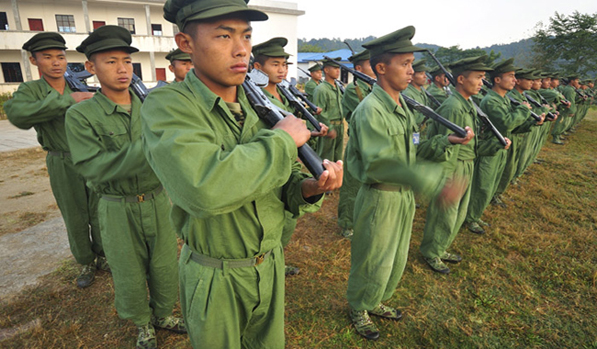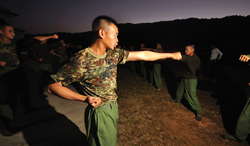The Path of Pen or Sword?

The path of the pen or the path of the sword? Young Kachin in northern Burma are preparing and learning on both fronts.
The question dates back to antiquity, but recently it has come to life here in Kachin State where the Kachin have struggled for autonomy for generations.
The Kachin Independence Army (KIA) fought an armed insurgency for more than 30 years. Despite being out-numbered and out-armed, the KIA was never fully defeated, but they were not able to win full autonomy for the Kachin people.
 |
But, the Kachin are making real progress. The liberated Kachin area now has native language schools, a TV station, intensive English colleges, a civil service academy, regular native language publications, a media center, several Web sites and a national library.
These institutions are the building blocks that make it possible, in the next phase of social development, to consider using the power of the pen—communication—as an effective tool to fight for ethnic autonomy.
Choosing to solve conflicts through the path of civil government and through the media instead of through armies and missiles is not an easy task. It’s been all the more challenging since the Kachin first had to create a civil government and mass media.
Mahatma Gandhi would have had little significance without the attention of India’s newspapers, radio and news stations spreading his words and ideas across the country, to the English commonwealth and around the world. But unlike Gandhi, the Kachin have not ruled out the use of military means as a way to ethnic autonomy.
They are, however, coming to understand that the media is as powerful as machine guns.
The question for the Kachin is how to harness the power of the media, and the question for the world is, how it can help them get their message out.
Burma’s pro-democracy leader, Aung San Su Kyi, has been effective at getting the attention of the world media, but the Kachin see their struggle for autonomy as separate from the larger pro-democracy movement.
Kachin leadership has yet to capture the attention of the world’s media. There are now more than 700 fulltime photojournalists active in Iraq. Kachin State has zero.
History has shown the Burmese military junta will not hand over autonomy to ethnic people. But, the more the world is able to see and hear the concerns and dreams of the Kachin, the more international pressure the junta will feel to provide for the aspirations of the Kachin people.
Recently, the Chiang Mai based NGO Documentary Arts Asia (DAA) taught a week-long journalism and photography workshop to Kachin youth. The young men and women—the journalists, photographers and researchers of tomorrow—were eager to learn. As part of their training, they published seven projects in the workshop magazine, Jingpaw.
DAA awarded two outstanding students cameras and it donated several cameras for community use.
Doi La, one of the workshop’s outstanding students, now has plans to put the skills he learned in the workshop to use by documenting Kachin traditional festivals. DAA has plans to keep working with Kachin youth, to publish their photographs and stories, and to offer another media workshop in 2009.
DAA considers the media workshop a success, but admits that much more needs to be done.
On the path of the sword, it’s possible to spend money to buy guns and train soldiers to fight in a matter of weeks or months.
On the path of the pen, it can take years of training to forge a group of people who can communicate effectively with words and photos.
KIO community organizer Mung Aung wants to study for a master’s degree in public administration with emphasis on public relations. He rightly sees such a goal as a way he can help his people communicate effectively with the international media.
Mung Aung admits there’s a “brain drain” going on in Kachin State now. Growing numbers of Kachin youth with his qualifications are leaving for jobs in other parts of Asia and the world.
1 | 2 next page »
- 'My Wife Died From Police Abuse,' Says Husband
- US Says Observer Conditions Don't Meet Int'l Standards
- 159 Observers to Monitor Burma Election
- Govt to Address Breaches of SSA-South Ceasefire: Aung Min
- Burma Investors Pin Hopes on Seminal Sunday
- Malaysia PM Leads 50-Strong Delegation to Burma
- US Congress to Assess Burma's Political Prisoner Issue
- Rangoon Woman in Police Station Death Plunge
- Burmese Legal System Remains Tool of Govt: AHRC
- Burmese Army Chief Defends Political Role
